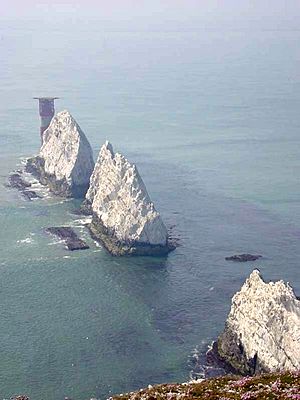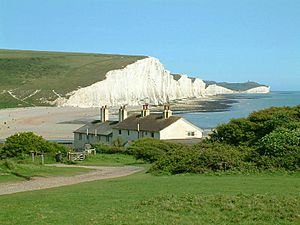Chalk facts for kids
| Sedimentary rock | |

|
|
| Composition | |
|---|---|
| Calcite (calcium carbonate) |
Chalk is a type of limestone. It's a soft, white rock. Chalk is strong against wind and water. This is why you often see it forming tall cliffs by the sea. The famous "White Cliffs of Dover" in Kent, England are a great example.
When chalk is close to the ground's surface, it often forms gentle hills. Chalk can hold water, so chalk hills often have a good water supply, even when it's dry. Chalk is mostly made from the tiny skeletons of countless tiny sea creatures called coccoliths. These skeletons are made of calcium carbonate (CaCO3). This rock formed a long, long time ago, during the Upper Cretaceous period.
Contents
How Chalk Forms
Ancient Seas and Tiny Creatures
About 90 million years ago, the land that is now chalk hills in Northern Europe was once the muddy bottom of a huge sea. Tiny living things, like foraminifera, lived in this ancient ocean. They ate the bits of dead plants and animals that floated down from the surface.
Their bodies were made of chalk, which they took from the rich seawater. When these tiny creatures died, their chalky skeletons sank to the bottom. Over millions of years, a very deep layer of these skeletons built up. Slowly, this soft layer was pressed and hardened into the rock we call chalk. Much later, movements in the Earth's crust pushed this ancient seabed upwards, turning it into dry land.
What Chalk is Made Of
Main Ingredients of Chalk
Chalk is mostly made of calcium carbonate. It also has small amounts of silt and clay. It usually forms underwater, often on the seabed. Over time, it gets pressed and hardened into the rock we see today.
During this hardening process, a substance called silica often gathers together. This forms hard lumps called chert or flint nodules inside the chalk rock.
How People Use Chalk

People have used chalk for a very long time in England. It was used as a building material. It was also used as marl to improve farm fields. Chalk is also used to make quicklime and slaked lime. These are mainly used in lime mortar for buildings.
In southeast England, old chalk pits called Deneholes are famous examples of how chalk was dug up. These bell-shaped pits might also be old flint mines. Here, people dug for flint nodules to make stone tools. The remains at Cissbury Ring are one such place. Perhaps the most well-known is the large area at Grime's Graves in Norfolk.
Modern Uses of "Chalk"
Many traditional uses of chalk have changed. Other materials are now used instead. However, the word "chalk" is often still used for these new materials.
- Blackboard chalk is used for drawing on rough surfaces. It crumbles easily, leaving small pieces that stick to the surface. While it used to be made of natural chalk, most modern blackboard chalk is made from gypsum (a mineral called calcium sulfate). It often comes in sticks of pressed powder.
- Sidewalk chalk is like blackboard chalk. But it's made into bigger sticks and often comes in many colors. Children and artists use it to draw on sidewalks, streets, and driveways.
- In agriculture, chalk is used to make soil less acidic. This helps plants grow better. The most common forms used are calcium carbonate (CaCO3) and calcium oxide (CaO).
- In sports like tennis, powdered chalk was used to mark the lines on the playing field. If a ball hit the line, a cloud of dust would show it. Today, a substance called titanium dioxide is mostly used instead.
- In gymnastics, rock-climbing, weight-lifting, and tug of war, people put chalk on their hands. This chalk is usually magnesium carbonate. It helps to dry sweat and stop hands from slipping.
- Tailor's chalk is a hard chalk used by tailors. They use it to make temporary marks on cloth. Today, it's usually made from talc (a mineral called magnesium silicate).
- Toothpaste often has small amounts of chalk in it. It acts as a gentle abrasive to help clean teeth.
- Polishing chalk is a special type of chalk. It has a very controlled grain size. This makes it perfect for polishing metals very finely.
- Chalk is a source of quicklime. This is made by heating chalk. If you add water to quicklime, you get slaked lime.
- Builders putty mainly contains chalk. It's used as a filler in linseed oil.
- Woodworking joints can be checked with chalk. You put chalk on one surface. Then you try to fit the two pieces together. The chalk will leave marks on any high spots of the other surface. If chalk covers the whole surface, it means the fit is good.
In the military, "a chalk" means an aeroplane carrying a special load. This is often a group of soldiers in one plane. For example, "U.S. Army Ranger Chalk Four" was a group of soldiers who were hurt in the Battle of Mogadishu in Somalia.
Images for kids
-
"Nitzana Chalk curves" in Western Negev, Israel. These chalk deposits formed in the Mesozoic era's Tethys Ocean.
-
A former underground chalk mine in Meudon, France.
See also
 In Spanish: Creta (roca) para niños
In Spanish: Creta (roca) para niños







